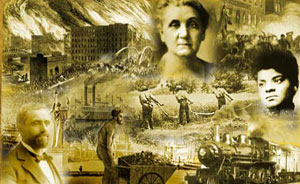talking history | syllabi | students | teachers | puzzle | about us
Illinois During the Gilded Age
http://dig.lib.niu.edu/gildedage/
Created and maintained by Northern Illinois University Library.
Reviewed June 2006.
This attractive and easy-to-navigate Web site, one of five Northern Illinois University digitization projects, invites users to explore the history of Illinois during the Gilded Age. Funded by a small grant of $30,000 from the Illinois Board of Higher Education, the site accesses sources from the Newberry Library, the Chicago Historical Society, and the Illinois State Library. While only 287 primary sources are currently available for viewing, new sources are being added all the time, and the project director, Drew E. VandeCreek, estimates that the number should at least double by the end of 2006.

The site is divided into three major parts: historical themes, a narrative of key events, and a “teacher’s parlor”; there is also a relatively undeveloped “cultural tourism” section. Each historical theme is divided into a short interpretive history, a bibliography of secondary sources, videos of historians, notably Maureen Flanagan, James Gilbert, and Michael Kazin, and a search engine to access primary sources. The bibliographies and the short interpretive essays, which range in length from one thousand to two thousand words, vary in quality. Some, such as the ones on labor, women, and religion and culture, demonstrate a solid grasp of the secondary literature and set local history in national context; others, such as the ones on politics, economic development, and immigration, slight local history in favor of a synthesis based on national developments. The breadth of local coverage would have been improved if historians more familiar with the wide literature in those fields had been asked to write them. The range of available primary sources is also skewed; the number of sources that cover the greenback issue and Abraham Lincoln is disproportionately high. The search engine used for retrieving the primary sources is easy to use, but because the number is so small, the user may want to begin by browsing the sources available and select from among these.
The site’s narrative history is divided into seven groups: the aftermath of the Civil War through the Chicago Fire, the 1870s depression, the 1877 railroad strike, the rise of the labor movement and its relation to politics, Haymarket and Hull House, the 1893 World’s Fair, and the pivotal 1896 presidential election. There is considerable overlap between those narrative histories and the interpretive histories in the historical themes section. Readers may save time by beginning with the narrative histories and then skipping directly to the bibliographies, primary sources, and videos. One drawback common to the narratives is the focus on Chicago developments and the paucity of attention given to rural and small-town Illinois.
A major strength of the site is the diversity of media it employs. In addition to videos, there are thirteen pages of images, many of them from the World’s Fair. The site also includes downloadable songs from the temperance and greenback-labor movements and the William Jennings Bryan-William McKinley campaign. Maps that show the breakdown of national voting results on key issues, such as the Interstate Commerce Act, add an interactive element to the site.
Teachers of high school advanced placement and college classes will find the nine lesson plans useful. Each examines a key Gilded Age issue, notably, civil service reform, the tariff, temperance, and the money question. Each lesson includes objectives, teaching materials, student preparation, group activities, questions for discussion, the state standards addressed, and notes on resources. Illinois during the Gilded Age is already a useful resource for teachers and scholars, and it promises to get even better.
Richard S. Schneirov
Indiana State
University Terre Haute, Indiana
